Mississippi Town’s Whites Rebel at Minority Status
- Share via
FRIARS POINT, Miss. — White residents are seeking what blacks in many Southern cities spent decades fighting for--a voice in their government.
Only 15% of the 1,300 residents of Friars Point, a Mississippi Delta hamlet, are white. Blacks fill all five positions on the Board of Aldermen. The last white alderman, Charles Wilson, lost a bid for reelection in June.
“Why should the rights of a white minority be any different than the rights of a black minority?” asks John Yount, who started a petition drive asking the board to create four wards, one with a 65% white voting-age population, with a fifth alderman to be elected at large.
Wants Accountability
Under a ward system, Yount said: “I don’t know if a black man or a white man will be elected out of our district, but at least he would be accountable to us.”
Yount said he passed the petition among about 80% of the nearly 200 whites in Friars Point, and received only 20 signatures.
There is little opposition to a ward system, but some question whether it should be drawn along the racial lines proposed by Yount.
“I don’t see--mathematically, no way--that we could draw a line putting all of the white people in the district and come up with a 65% ward,” said Mayor James Washington, who is black. “There’s no way.”
But Washington added that he and the board favor a ward system.
Town attorney Hunter Twiford said he had prepared a recommendation for changing the town government to a ward system and planned to present his proposals to the board. The board then must decide whether to order a demographic study for drawing up the wards.
If the board does vote to change, it would have to get U.S. Justice Department approval under the Voting Rights Act of 1965, which requires prior approval of all election changes in Mississippi.
Friars Point was founded in the early 1830s by John Friar, who came ashore by flatboat from St. Louis. The river town in northern Mississippi prospered for about 50 years in the days of the steamboat until railroads took over, then became a mostly white farming community.
In the late 1940s, mechanization pushed black field hands into town looking for work, and whites gradually became the minority.
About 150 whites live in a sliver of suburbia near the Mississippi River levee, surrounded by larger black neighborhoods. Blacks work for whites, rarely vice versa.
Yount says the ward system is the whites’ only chance of getting representation, and that they will go to court if necessary.
“We’re not trying to decrease the authority of the board,” said Yount, 42, who manages the main office of a farming operation in nearby Marks. “If (Wilson) had been reelected this past time, this would never have come about. We have houses there, we have property there. We want to be involved in city government.”
More to Read
Sign up for Essential California
The most important California stories and recommendations in your inbox every morning.
You may occasionally receive promotional content from the Los Angeles Times.













